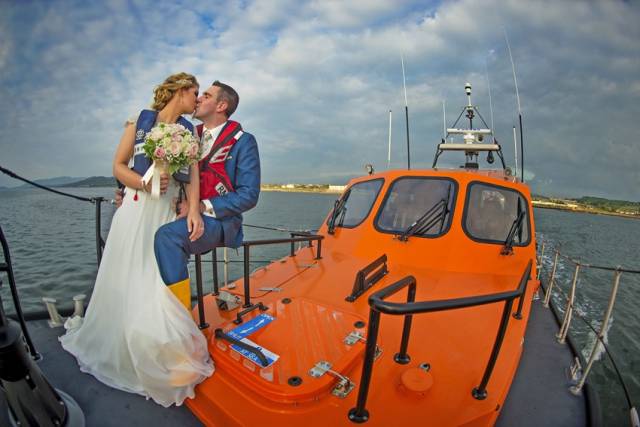#RNLI - Buncrana man Francy Burns wed his sweetheart, Carndonagh woman Helen McFarland, last Saturday 8 October in a wedding attended by their family, friends and the volunteers with Lough Swilly RNLI.
But it wasn’t all plain sailing, as after the vows were exchanged and Francy took the microphone to make his wedding speech, the lifeboat pagers went off and the volunteer lifeboat crew jumped to their feet and raced out of the room to the callout.
The incident was a reminder to Helen of what she can expect married to a lifeboat volunteer.
However, as Francy was preparing to follow his lifeboat colleagues and head out the door to the callout, the coxswain assured him they had enough crew and he could stay where he was and enjoy the day.
The callout was to a vessel with one person on board which had lost engine power and had been drifting for three hours.
Lough Swilly RNLI launched their new Shannon-class lifeboat and brought the vessel to safety, with the lifeboat crew returning to the wedding reception some hours later.
As the wedding reception was held in the Gateway Hotel, Francy had the perfect view out the window down on the berth from where the lifeboat is launched.
“It was certainly a day of mixed emotions,” said Francy. “I married the most beautiful and amazing woman but when I saw the crew stand up to head out for the lifeboat shout during my speech my first thoughts were to follow them.
“You never know what you are launching to but thankfully it was fairly straightforward. Helen understands how I feel about the lifeboat and she is fully supportive. You never know, I might even persuade her to sign up too.”
Lough Swilly lifeboat volunteer crew member and press officer Joe Joyce added: “The launch sort of added to the whole day. You couldn’t have planned it better.
“Everyone with Lough Swilly RNLI wish Francy and Helen every happiness on their marriage and we will see Francy down at the station for our next shout.”































































